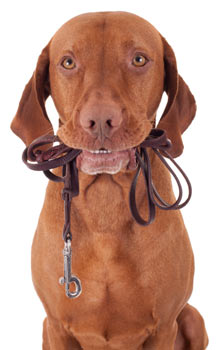Walking Your Dog to Help with Weight Loss

Dogs today have a higher likelihood of becoming overweight than ever before. People are often busy, and it's easy to forget that dogs that are sedentary will gain too much weight just like people will. Beginning a walking routine with your dog can help her achieve healthy weight loss. Plus, it's good for you, too.
Where to Start
Before you begin a new exercise regimen for your dog, visit your veterinarian to get the go-ahead. Making sure that your canine buddy is fit and ready for weight loss will help prevent any unforeseen problems. Your veterinarian may also want to check for any medical conditions such as hypothyroidism that may be adding to your dog's weight problem.
Be sure to ask your veterinarian for recommendations on what and how much to feed your dog. Using the proper nutrition plan will ensure that your exercise efforts yield the best possible pay-off. When you visit the veterinarian, find out your dog's current weight so you will be able to track progress.
Gather Your Gear
To make sure that you and your dog are as safe and comfortable as possible during your walks, you will need the following items:
- Collar with ID tags: Just in case your dog gets away from you and becomes lost, always be sure that she is wearing a collar with current ID tags.
- Dog license: Check with your veterinarian to make sure that your dog is current on any licenses that are required in your area. If you will be visiting dog parks during your walks, make sure you know if they have any vaccination or permit requirements.
- Six-foot leash: This is the length of leash that works best for most dogs. Don't use a retractable leash because, among other things, it gets too long to maintain safe control of your dog.
- Sweater and booties for smaller or short-haired dogs: Depending on the weather, some small or short-haired dogs might do better wearing a sweater and booties.
- Head-halter or harness: It is safer to walk your dog using a body harness such as this one than with a leash attached to the collar. Neck injuries can occur with collar leashes if your dog pulls or suddenly jerks in a different direction from you. Some large dogs that tend to pull on a leash will do better with a head halter such as the Gentle Leader.
- Pick-up bags: Never leave home without a way to clean up your dog's feces! Leaving it lying around won't make you any friends in the neighborhood. Biodegradable bags are a great way to soften your dog's effects on the environment.
- Mobile phone: Taking your phone with you ensures that you have a way to get help if anything unforeseen happens during your walk. Make sure that you program in your veterinarian's number and that of the local veterinary emergency clinic. However, avoid talking on or looking at your phone while you're walking unless you have an emergency. You'll need to pay attention to what your dog's doing and what's going on around you.
- Water: Anytime you take your dog for a walk, make sure that you bring water for both of you. Even on a cool day, dehydration is a common occurrence when activity is involved. A canteen is a great way to carry your dog's water for her.
Start Slowly
If your dog hasn't had much exercise in the past, you'll want to start slowly in order to minimize the chances of injury, sore joints, and raw foot pads.
Per Dr. Marty Becker, Chief Veterinary Correspondent for the Dr. Oz Show, a good rule of thumb for walking distance when your dog is starting out is 200 yards (about 2 city blocks) per 10 pounds of body weight twice a day. Increase that distance by about 10% once a week.
Keep at It
Don't be concerned if your dog doesn't lose weight quickly: slow and steady is a healthy way to approach weight loss in humans and dogs. Just keep up with your exercise and nutrition regimen, and your dog will be healthier and happier.
For more tips on weight loss for dogs, check out this article.
You May Also Like These Articles:
Dog Weight Loss: Tips For Helping Your Dog Lose Weight
Obesity in Dogs: Overview of Causes and Dangers
How to Be Prepared for Your Dog's Veterinary Bills
Keeping Your Dog Active While You're Away
Disclaimer: This website is not intended to replace professional consultation, diagnosis, or treatment by a licensed veterinarian. If you require any veterinary related advice, contact your veterinarian promptly. Information at DogHealth.com is exclusively of a general reference nature. Do not disregard veterinary advice or delay treatment as a result of accessing information at this site. Just Answer is an external service not affiliated with DogHealth.com.
Notice: Ask-a-Vet is an affiliated service for those who wish to speak with a veterinary professional about their pet's specific condition. Initially, a bot will ask questions to determine the general nature of your concern. Then, you will be transferred to a human. There is a charge for the service if you choose to connect to a veterinarian. Ask-a-Vet is not manned by the staff or owners of DogHealth.com, and the advice given should not delay or replace a visit to your veterinarian.


